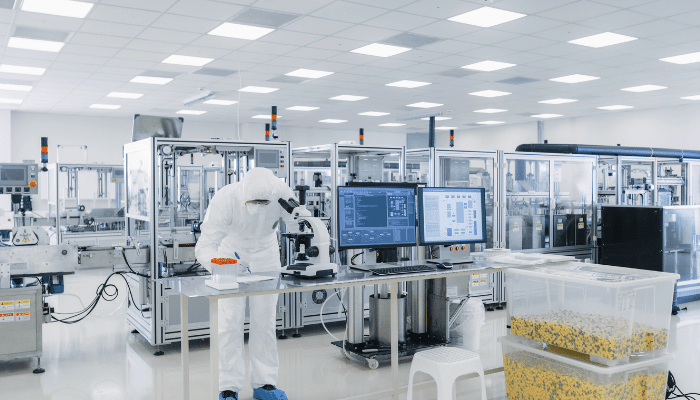3 Vital Benefits of Smart Manufacturing
Transforming your industry 3.0 factory into an industry 4.0 smart factory is becoming more of a standard, and less of a “nice to have.” Our team at Ectobox saw this coming, and we’re excited to see more and more manufacturers become data-driven and take advantage of the benefits of smart manufacturing.
We live in a Smart World
Today, there is a “smart” everything and manufacturing companies are not getting left behind on this trend. Technology continues to advance at a quick pace in the 21st century. We have smartphones, smart TVs, but that’s old news at this point. Now we have smart lightbulbs, smart toasters, smart dental floss dispensers. Yeah, I’m not kidding, go ahead and look it up yourself.
10-15 years ago, you didn’t need to have a smartphone. It was cool to have and useful to a lot of people, but you weren’t weird or behind the times if you didn’t have one. Flash forward to today, you are completely lost without a smartphone. Can’t do a quick google search from your pocket-sized computer? Can’t check your email? Get directions anywhere in the world? We can’t live without these things today. Smartphones started as a cool option for people that wanted to spend a little extra money, now nobody can function without them.
Smart Factories are the Future of the Manufacturing Industry
My point is, the world is smart, the entire world has gone under a digital transformation. The manufacturing industry is no exception. While this industry isn’t using smart dental floss dispensers and toasters, manufacturers should be turning the factory floor into smart factories and taking advantage of smart manufacturing technologies.
In this article, I will go over 3 key benefits of smart manufacturing that you should be considering today so that you can “future proof” your business.
Increased Efficiency with Real-Time Data
Tesla, Amazon, and Apple among other manufacturing companies, are constantly innovating and improving their manufacturing processes. If these businesses believe that they still have room for process improvement, then you definitely do too.
There will always be places to squeeze out more throughput, increase capacity, cut back on downtime, etc. Adopt a proactive continuous improvement mindset.
Make Quick Decisions and Take Action
It’s really hard to make improvements that actually help without much substance or information to base your decisions on. Furthermore, it’s tough to measure success without seeing the numbers. How do you really know if the adjustment you made helped or not? If it did help, how much did it help?
This is where smart manufacturing benefits you and can step in to lend a hand. The Industrial Internet of Things (IIoT), Manufacturing Execution Systems (MES), and other similar solutions are equipped with the ability to deliver real-time data to decision-makers to make quick decisions and adjustments on the factory floor. Then, you can use the same system and metrics to measure success instantly. These flexible solutions provide you with the resources you need to reduce waste, improve operations, and take the organization to the next level.
Don’t Get Stuck in the Past
How long would a process similar to this take if someone had to manually record even basic data on the factory floor, deliver it to a decision-maker, receive an answer, and execute? It’s extremely tough to do in an efficient, timely manner. This process certainly would not take a few minutes. The data alone will take many hours, if not days to even be ready to be analyzed.
This is one truly of the major advantages of smart manufacturing, this process can be streamlined.
Some manufacturers are willingly choosing to ignore these advancements in technology. Soon, it won’t be “trendy”, it will be the standard. Companies will either have to adapt and change to the new ways of manufacturing, or they will watch competing companies continue to move up and surpass them.
There is always some company out there willing to do your job better, cheaper, and faster. Today, the tools are readily available for people to take advantage.
A Real-World Smart Factory Comparison
Circling back to the smartphone example I mentioned earlier. Yes, if you have a “dumb phone,” you could still drive to a gas station, buy a map, and then use that to get where you need to go. Or, with a smartphone, you could type your destination address in and be on your way in 10 seconds. The same idea can be applied to a manufacturing business and its manufacturing process.
Data is delivered instantly in real-time, nobody walking around the shop floor handing out information, gathering information, no operators stopping work to write down their data during a shift.
Not only is manual data entry a slow and inefficient process, but it’s also poor communication. How often does that data get to anybody else on the plant floor? especially in a timely manner for that data to actually be useful.
Seamless Communication
This leads us perfectly into our second smart manufacturing benefit- seamless communication.
This is one that not many people really talk about or make a big deal about. However, smart manufacturing revolutionizes the way people communicate with workmates, employees, customers, machines, and data.
Here’s why this is so important. Wasted time and wasted motion = lost production time and an efficient process. This goes against lean principles which many manufacturers attempt to follow. Strive to eliminate waste and increase efficiency.
Smart manufacturing can have a positive impact on a variety of different communication scenarios such as:
Machine to Employee:
- Machines deliver data in real-time, constantly providing contextual, actionable information to operators and other employees. This information is instantly made available to each person within the business.
Employee to Machine:
- Employees and operators can analyze data points to make data-driven decisions to improve operations in areas such as quality, maintenance, and throughput.
Sales Team to Customers:
- When customers call for an update on their job or a progress update, the sales representative can look at the data in real-time and give the customer an extremely accurate data-based answer with detail on how much is done, how much is left, and when they can expect delivery. No guesswork, just facts.
Better Communication Means Better Manufacturing
The communication benefits of smart manufacturing are revolutionary and will undoubtedly save you a headache here and there, promote knowledge sharing among the staff, help drive innovation, improve productivity, and improve customer relationships.
Most manufacturers don’t realize how much time and money they could be saving (or how much they are currently wasting) before implementing smart factory technologies.
We have come across clients that have told us that they have people in the company that are consistently spending half of their day running around the plant floor trying to find a certain order for a customer. What a waste of valuable time!
Efficient processes = more production, more production = more time for more clients, good communication = happy customers, happy customers = return customers, and all of this = more revenue in less time. Learn how to do more with what you already have- That’s the name of the game in 2022 and beyond especially when you take into consideration the workforce shortage that doesn’t seem to be getting any better.
Smart Manufacturing Creates more Jobs
Some people will say that automation is going to take over human jobs in manufacturing and that IIoT and the fourth industrial revolution are going to turn everything into an automated process putting many people out of work. This is not the case at all. While it is true that there are some jobs that will likely be largely handled by machines and artificial intelligence (AI). IIoT, smart manufacturing, and the fourth industrial revolution create more new jobs.
The Workforce Shortage and Knowledge Gap
It’s no secret that there is a shortage of skilled employees in the manufacturing sector. The industry is filled with a lot of people closing in on retirement. Furthermore, there isn’t a large number of young people that want to go into the manufacturing industry. What do young people want? Tech jobs (source). There is a lot of young people that want to do something related to tech. That is where everything is headed, technology drives our world today.
Correspondingly, what will all of these smart manufacturers need? They will need people to fill these new jobs created by smart manufacturing and smart factories. See where I’m going here?
Manufacturers will have new needs for people who can work with new technology, software, and data.
So, no, smart manufacturing and IIoT are not going to take away manufacturing jobs. They will create new, different jobs. Jobs that might be more appealing to the younger generation. These new jobs will help boost up the manufacturing workforce, which desperately needs it.
Conclusion
These three benefits of smart manufacturing are huge, and they are shaping the future of the industry.
Keep in mind, this is just the tip of the iceberg, there are numerous other benefits and sub-topics centered around smart manufacturing and the smart factory, such as smart machines, machine learning, connected systems, data-driven manufacturing, and predictive maintenance, automated production scheduling, connecting the supply chain, and the list goes on.
For more information on any of these topics, check out the rest of the Ectobox blog, we’re passionate about providing manufacturers with the resources and technologies they need to thrive in a high-efficiency, high-quality digital future.
Start your journey today. Put yourself ahead of the curve so you don’t get stuck in the old ways of manufacturing.








